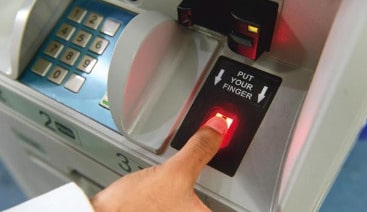Banks and other financial institutions across the globe have been adopting biometrics as a way to improve the customer experience and increase security against identity fraud, such as money laundering or account takeovers.
Biometrics are used by banks to onboard customers and authenticate them after onboarding when conducting transactions, such as at ATMs. Biometric authentication can help ensure that transactions are not fraudulent — and are less time-consuming than the traditional ways that banks reach a high level of assurance that the right person is accessing the account. Banks are also using biometrics as an internal control, securing staff access to sensitive data and restricted areas.
Fingerprints are the most common modality of choice for bank biometrics due to their speed, ease of use, high accuracy and cost-effective nature.
For example, Banco Superveille in Argentina uses fingerprints to verify the identity of pensioners collecting their benefits. Before adopting biometrics, the bank could only prevent fraudulent claims by the relatives of deceased pensioners by making all claimants go through a time-consuming authentication process. The decisions made by Banco Superveille to use fingerprint authentication present a good real-world example for other organizations to provide a more secure and better experience for staff and pensioners.
The benefits of biometrics in banking
The security and compliance benefits of biometrics are significant drivers of the technology’s adoption among financial institutions. All banks are subject to know your customer (KYC) and anti-money laundering (AML) regulations that involve identity verification to a high level of assurance for new customers.
Biometrics are one of the few ways of meeting the identity assurance standard these regulations require. An in-person fingerprint scan is the same method of identity verification the U.S. federal government uses to perform background checks.
The strength of identity assurance that provides regulatory compliance also protects against fraud. High-accuracy fingerprint scanners can provide this security and compliance, while improving the customer experience.
As an emerging technology, fingerprint biometrics can also help to build the brand of organizations that adopt them. The use of advanced technology creates confidence in many customers and demonstrates the bank is not stuck in the past.
Choosing the right fingerprint scanner for your bank
The standards behind KYC and AML regulations cannot be met with the fingerprint scanner on a mobile phone. Instead, banks deploy dedicated hardware to achieve the benefits of biometrics within branches.
As a relatively mature biometric modality, there are standards used throughout the world for fingerprints, notably including the U.S. Federal Bureau of Investigation’s Next Generation Identification (NGI) Image Quality Specifications (IQS). The common standard for image quality assessment is provided by the National Institute of Standards and Technology (NIST).
The FBI standards are often referred to in procurements around the world, with for instance the PIV (Personal Identity Verification) specification ensuring interoperability and quality of single finger scanners used for one-to-one biometric matching. The NIST Fingerprint Image Quality (NFIQ) 2 is open source software for assessing the quality of fingerprint images, with reference to the ISO/IEC 29794-4 standard for biometric sample quality.
Banks in many countries must also adhere to mandates and fit into ecosystems that involve the specifications used for national ID cards.
The right biometric scanner must also provide sufficient accuracy to work at scale, while providing the right user experience. A financial institution with tens of millions of customers must match only the correct user to their account. While fingerprint biometrics tend to have low false accept rates, in which the wrong person would get into an account, cheap fingerprint scanners have higher false rejection rates, in which the legitimate customer is not matched. Scans should work the first time to deliver the kind of confidence and experience customers expect.
For example, Banco Superveille selected fingerprint readers powered by multispectral imaging (MSI) technology so they could consistently match the aging fingers of elderly customers in any challenging lighting conditions and harsh environments, and the bank was able to authenticate more than a million retirees faster than expected with fingerprint scanners.
Liveness detection is another important consideration, providing protection against relatively sophisticated fraud attacks. Fingerprint scanners that use advanced imaging, like MSI, can provide this capability, which is not available with some low price fingerprint scanners.
The standard for liveness, or presentation attack detection (PAD), is ISO/IEC 30107. Testing for compliance to this standard is available from independent laboratories and shows the effectiveness of biometric systems against attacks with varying levels of sophistication. The highest level of testing against this standard from NIST-accredited labs is ISO 30107-3 PAD Level 2, which moves beyond simplistic fakes to consider effectiveness against 3D prosthetics and sophisticated fakes made with silicone and latex.
Independent PAD Level 2 testing to the ISO standard illustrates another way in which multispectral fingerprint scanners such as HID’s Lumidigm V-Series are appropriate for high-security use cases like bank transactions.
Multispectral fingerprint scanners have been proven effective for use cases where security, consistency and accuracy are important. Leading biometrics device providers can help financial institutions integrate advanced fingerprint scanners into their business processes for improved security and customer experience.
Tightening regulations, increasing fraud concerns, and advances in biometric technology combine to make this the appropriate time for many of the banks and financial institutions that have not yet adopted fingerprints for in-branch identity verification to do so.
Read HID’s recent eBook, “A Definitive Guide to Fingerprint Technology,” to explore popular fingerprint sensing technologies, common use cases and a checklist on key considerations for selecting the right readers for your bank.
Article: Why banks worldwide are turning to fingerprint biometrics
